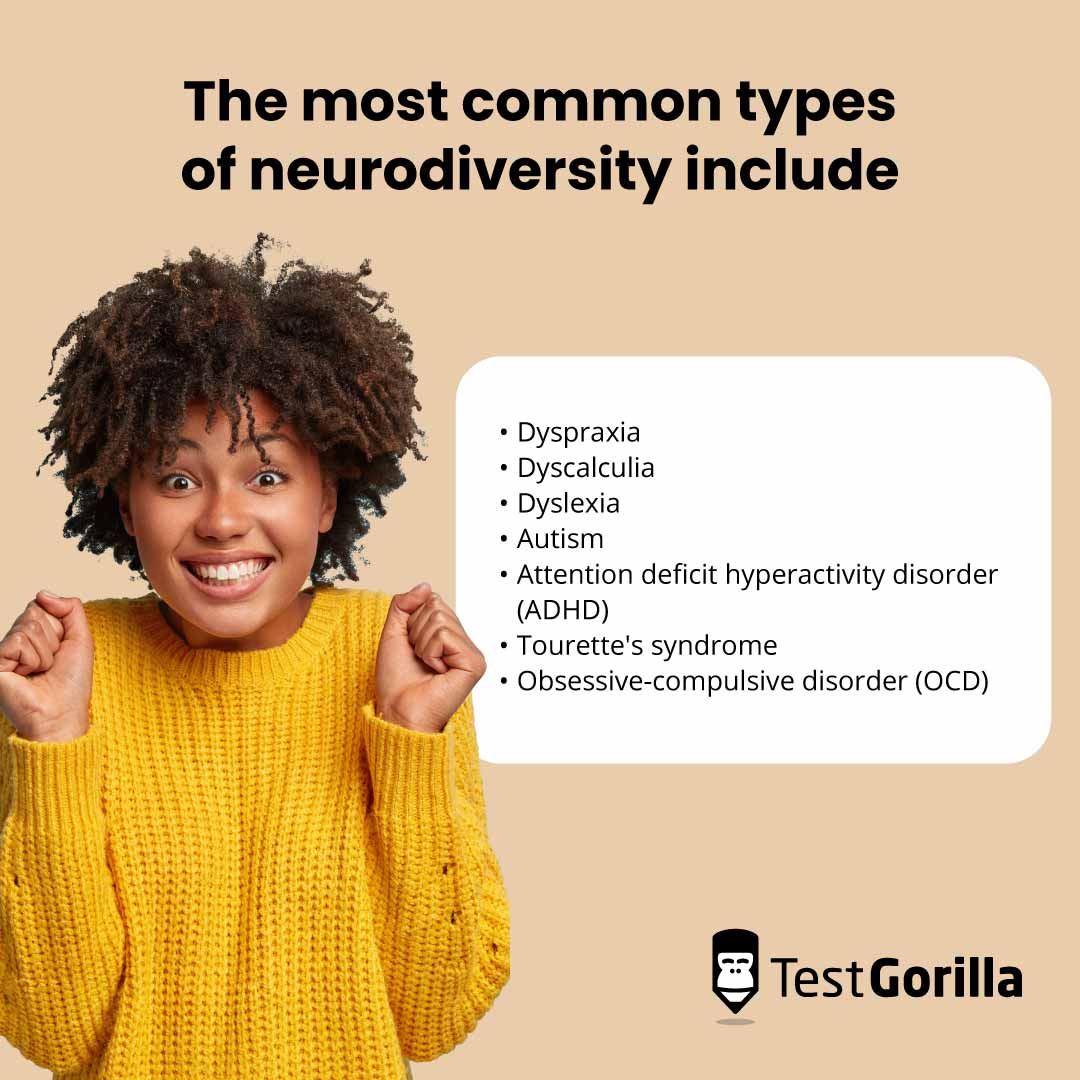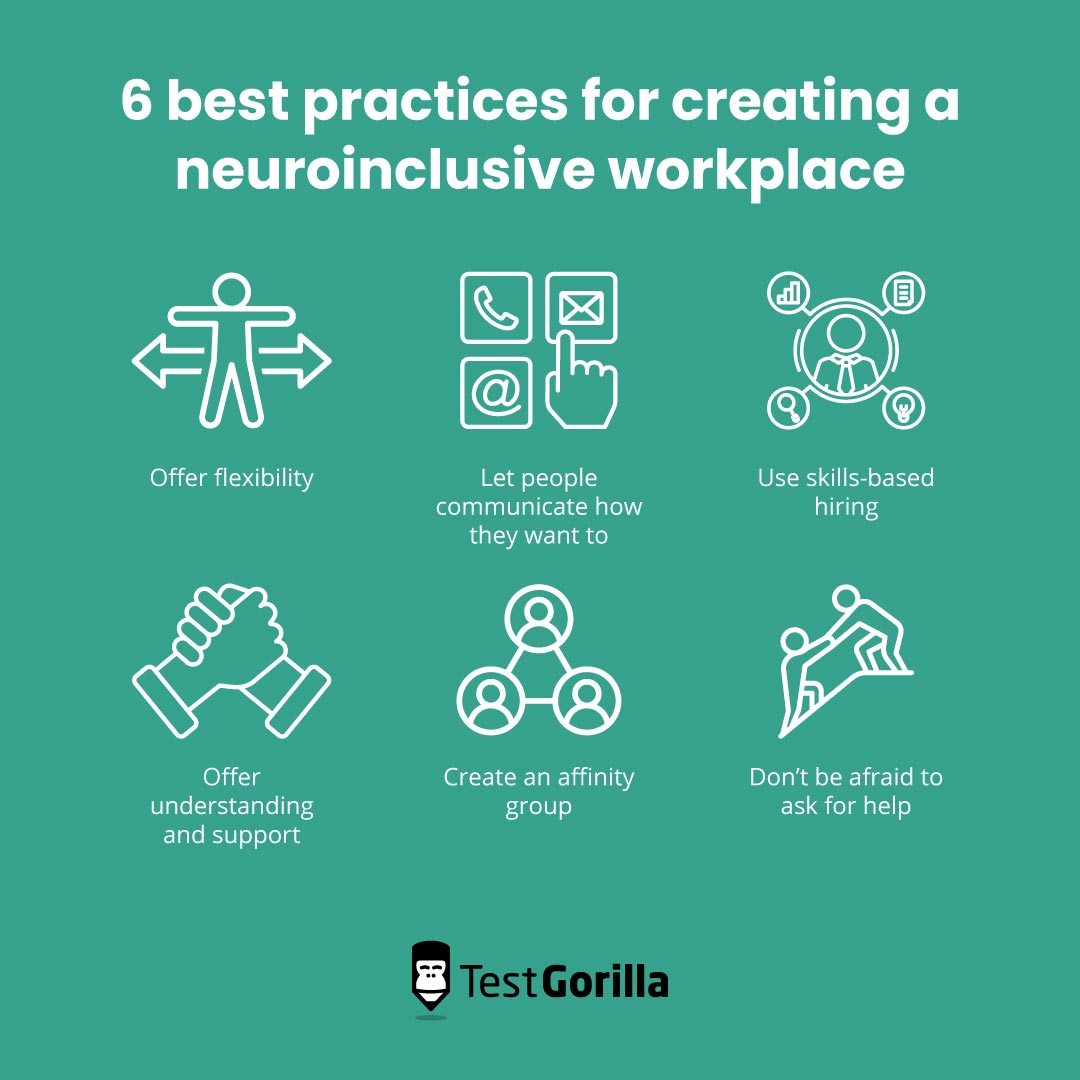Neurodivergent adults are more likely to be unemployed than any other group. [1] Despite bringing unique skills and talents to the workplace, they face bias, discrimination, non-inclusive hiring and retention practices, and a lack of employer awareness and support at work.
Having the right people in the right roles and supporting them, regardless of whether or not they’re neurodivergent, sets your business apart from competitors and gives you a key advantage.
In this piece, we’ll look at some of the challenges faced by neurodivergent people and the actionable steps you can take to support them and make sure your hiring and retention efforts don’t leave them out.
We’ll also examine how skills-based hiring can help neurodivergent individuals overcome the challenges involved in traditional recruiting practices.
Table of contents
- If you’ve met one neurodivergent person…
- Challenges for neurodivergent workers
- Opportunities for organizations
- 6 best practices for creating a neuroinclusive workplace
- 2. Let people communicate how they want to
- 4. Offer understanding and support
- 5. Create an affinity group
- Neuroinclusivity in the workplace: One for all and all for one
If you’ve met one neurodivergent person…
… then you’ve met one neurodivergent person.
Neurodiversity comes in all shapes and sizes. It’s an umbrella term referring to the natural variations in our brains and how they function. Essentially, it’s the idea that people experience and interact with the world around them differently.[2]
It would be as if some individuals saw the world through blue-colored glasses, while others looked at it through pink, purple, or even green lenses.
Some of the most common types of neurodiversity include:
Dyspraxia
Dyscalculia
Dyslexia
Autism
Attention deficit hyperactivity disorder (ADHD)
Tourette’s syndrome
Obsessive-compulsive disorder (OCD)
Neurodiversity encompasses a range of conditions and abilities and creates challenges in various aspects of life, including at work. Let’s take a look at what some of those are.
Challenges for neurodivergent workers
The way neurodiverse employees navigate their workplace can be influenced by their specific cognitive profile, including differences in communication, social interaction, sensory processing, and behavior. This can make it difficult for them to thrive in traditional work environments that aren’t set up for their needs.
To put this in context, only 29% of autistic adults are employed.
Some other challenges neurodivergent individuals face include:
Conscious and unconscious bias: While neurodiversity is becoming more and more accepted, neurodiverse workers still face discrimination and a lack of understanding. The stigma attached to neurodiversity can cloud the judgment of recruiters, managers, and existing employees, even unintentionally. As a consequence, they can be excluded from opportunities or even laid off when they don’t “fit in” with the rest of the team.
Unsuitable work environments: Neurodiverse people are often left out when it comes to designing work environments. For example, bright lights, loud noises, strict dress codes, and rigid routines can all lead to sensory overload for these employees. This can create higher levels of anxiety and stress and lower productivity.
Inflexible workplaces: Adaptation is key to helping neurodivergent professionals make the most of their abilities and better leverage their unique strengths. Without, for example, having autonomy over schedules and working hours, it can be harder for neurodiverse folk to avoid overstimulation and stay focused.
However, defining the narrative of neurodiverse individuals based on their hardships and challenges does them a disservice. Let’s take a look at the benefits of helping your neurodiverse employees thrive.
Opportunities for organizations
Making a concentrated effort to hire more neurodiverse candidates benefits an often overlooked group of workers. It also helps companies unlock access to talents and skills that are unique to neurodivergent people.
“In my early 20s I worked as a waitress…and when the bar or the restaurant was really busy, the other waiters and bartenders [couldn’t] keep up [with the pressure]. But I was totally calm… You might not think that this thriving in chaos quality transfers to a tech job, but it does…”
– Sheena Muirden, owner and writer at Wax & Needle
As a result, organizations can build a diverse workforce that transforms their business. That’s because people with diverse cognitive abilities and experiences bring fresh, out-of-the-box thinking – and approach issues from a different perspective.
This gives your company an edge over your competitors because your teams can be more innovative, solve problems more creatively, and present clients with the best possible results.
“I told my boss I have ADHD and they said: ‘is that why you’re late sometimes?’ I said yeah, but it’s also the reason I’m stupidly creative, which will inspire innovation and drive business growth. I have amazing intuition so I can spot a gap in the market before anyone else…. So yeah, it’s the reason I’m late sometimes, but I’m also a valuable asset to your company and my unique brain gives your company a competitive advantage.”
– Alex Partridge, founder of UNILAD and LadBible, ADHD Chatter podcast host
6 best practices for creating a neuroinclusive workplace
While there’s still work to be done, there are many steps people-centric organizations can take to create a safer, more inclusive workplace for their people. In fact, some organizations have made it their mission to help other businesses be more neuroinclusive.
Neurodiversity in Business
Neurodiversity in Business is a UK business forum and industry group for companies to exchange best practices on neuroinclusive recruitment and retention strategies.
Their goal is to help foster a corporate environment where neurodivergent people are understood and included as part of the work culture.
To do this, they’ve created a best-practice business community with insight for:
Employers: To raise awareness of the benefits that neurodiverse individuals can bring to the workplace.
The Neurodivergent: By empowering, recognizing, and guiding neurodivergent workers towards a successful career path.
The Neurotypical: To give this group more understanding of their neurodivergent colleagues and encourage them to be more supportive and respectful.
“NiB’s goal is to improve the working lives of neurodivergent people, helping to unlock the unique and innovative contribution they can bring to the business world and society.”
Dan Harris, founder, Neurodiversity in Business
Inspired by the goals of Neurodiversity in Business, here are six best practices that every company can adopt to create meaningful change for the professional future of neurodiverse individuals.
1. Offer flexibility
A flexible work environment reduces stress levels for neurotypical employees and helps neurodiverse individuals to navigate work better. For example, many neurodiverse people experience sensory sensitivities so they may prefer to work from home to avoid noise, distractions, or social anxiety.
By offering flexibility, you can allow them to choose the work setting that suits their sensory needs, communication style, and work habits.
Additionally, your neurodiverse employees may need more flexibility in their work schedules due to healthcare needs or fluctuating energy levels. Letting your people complete their work at the times when they’re most productive helps them produce better results, prioritize their mental health, and avoid burnout.
Consider implementing a flexible work policy in your organization that includes remote or hybrid work options, dress-code flexibility, and even unlimited PTO.
Integrating this policy into your company culture makes it more effective. It also helps you attract and retain a diverse and talented workforce, improve employee engagement and satisfaction, and boost performance and competitiveness.
Remember: Designing for neurodiversity isn’t just beneficial for neurodiverse individuals – it helps everyone. For example, providing written and concise instructions for projects not only helps neurodivergent employees follow the task better. It also reduces misunderstandings, confusion, and duplicated work for all employees.
2. Let people communicate how they want to
Flexibility isn’t just about offering remote work options. It’s also about allowing people, neurodivergent and neurotypical, to communicate in the way they do best. This creates a more inclusive environment and leads to higher levels of productivity.
In fact, almost 50% of employees say that using their preferred communication method at work makes them feel more productive. Another 44% say it makes it easier to understand more of what others say.
Some neurodivergent people may prefer written communication over verbal communication, or vice versa. While others may need more time to process information or respond to questions.
By allowing your people to communicate how they want, whether it’s through Slack, email, Looms, video calls, phone calls, or face-to-face meetings, you can help them feel more valued and supported. You’ll also make it easier for them to contribute more of their unique skills and perspectives, and not feel stressed while doing so.
3. Use skills-based hiring
Skills-based hiring levels the playing field by giving you an objective, data-backed method to recruit diverse talent. This approach reduces the bias found in resume-based hiring by assessing relevant, measurable skills, and helping recruiters see a candidate’s capabilities in action.
Neurodivergent individuals can struggle with social communication, executive functioning, or sensory processing. This can make it hard to cope with the expectations of a typical work environment or interview setting where they’re judged by their social and communication skills.
By removing these barriers, you can find the right person for the job regardless of how well they maintain eye contact or how fast they speak.
In our 2022 State of Skills-based Hiring report, we found that:
91% of employers who used skills-based hiring saw an increase in workplace diversity
92.7% reduced the number of mis-hires
89.8% reduced the overall cost-to-hire
72.1% of people hired through pre-employment assessments were happier in their roles
Top tip: Before a skills-based test or interview, make sure to ask candidates if they need special accommodations. They might be hesitant to ask for it themselves, or might not know that it’s an option.
4. Offer understanding and support
Offering accommodations and being supportive of your neurodiverse people is the key to enhancing their well-being and making your company a great place to work. There are many ways to do this, including:
Creating transparent and fair recruitment and onboarding programs that not only welcome neurodiverse professionals, but also encourage them to be themselves. One way to do this is by writing inclusive job ads.
Educating HR professionals, managers, and employees alike on neurodiversity, unconscious biases, personal work styles, and how to provide feedback.
Including mental health support, resources, and education in your compensation package.
Providing various modes of learning and training, such as visual aids, audio recordings, written materials, or hands-on demonstrations.
Offering adjustments in the work environment like quiet spaces, assistive technology, noise-canceling headphones, or ergonomic furniture.
“Noise-canceling headphones are an absolute lifesaver. When I was working at an office, I asked if I could wear them because it would help me get things done quicker. They allowed it, but during my exit interview, my boss mentioned it as a negative thing about me. But headphones help me focus. Otherwise, I get overstimulated and distracted by the noises around me.”
–Natalie Siegfried, Animation Concept Art graduate at Vancouver Film School
5. Create an affinity group
An affinity group is a space where people with similar goals and identities – like neurodivergent employees – can connect, offer support, and voice any concerns. It creates a welcoming and safe environment that helps people feel heard while giving you and your leadership team a way to receive feedback on how company policies are going in practice.
Additionally, it gives neurodivergent team members the chance to share their experiences with their colleagues candidly, without a need to “mask” or put on an act to be socially accepted. By setting up an affinity group, you can make it easier for people to be themselves and support each other.
To make affinity groups successful:
Invite everyone to join different affinity groups regardless of their identity. This creates an opportunity for other employees to learn more about each other’s uniqueness, ask questions, and be allies.
Don’t expect team members to attend affinity group meetings outside their working hours. Work these meetings into your people’s working hours.
Remember to encourage discretion. For example with LGBTQ+ affinity groups, there will be people who aren’t ‘out’ in the company; they might want to have other LGBTQ+ people to talk to without being ‘outed’ to the rest of the company.
Allow for two levels of membership: one for those who share the characteristics of the group, and one for allies
.
In the case of neurodiversity, the 2 levels would be those who are neurodiverse and those who want to show understanding and support to their neurodiverse colleagues. Having this distinction is key to making affinity groups successful.
6. Don’t be afraid to ask for help
Diversity and inclusion is a long, but necessary road to walk. The good news is that you don’t have to walk it alone.
Our understanding of other people’s experiences can only take us so far. To build a truly inclusive workplace, ask your people directly about what they struggle with and what they need to be their best selves at work.
Do they use any helpful hacks in their lives outside of work that can be adapted to the work environment? Did they have access to a certain accommodation in a previous workplace that they don’t have in your company? What can you do to support them?
By having a constructive, open dialogue with your people and building a culture of open feedback, you can make changes that improve employees’ lives. And if you need more help, don’t be afraid to bring in professional help.
Neuroinclusivity in the workplace: One for all and all for one
As time goes on, more and more organizations around the world are taking steps to become more neuroinclusive. Not just because it’s the right thing to do, but because it benefits their business by making it more innovative and high-performing.
Neurodiverse individuals still face challenges at work, which combined with conscious and unconscious bias and an over-reliance on outdated hiring practices, creates an uncomfortable employment gap for them.
That’s why companies should adopt some best practices to address these challenges and create safer, more inclusive workplaces for their neurodiverse employees.
In this piece, we’ve looked at some ways you can do just that – from offering more flexibility and letting people communicate in their preferred way to creating affinity groups and asking for help when you need it.
We’ve also reviewed the benefits of using skills-based hiring and how this data-backed recruitment method can give applicants from all backgrounds and identities a fairer experience. Skills-based hiring makes it easier to break free from the rigidity of traditional employment models and tap into the diverse set of skills of neurodiverse professionals.
Diversity and inclusion isn’t just another business project. It’s about building a strong company culture. Find out how skills-based hiring can help you build happier, more productive teams from a wider talent pool. Download the 2022 State of Skills-Based Hiring report to learn more Sources:
“The Center for Neurodiversity and Employment Innovation.” The University of Connecticut. Accessed May 3, 2023. https://entrepreneurship.uconn.edu/neurodiversitycenter/
“What is Neurodiversity?” Harvard Health Publishing. Accessed May 3, 2023. https://www.health.harvard.edu/blog/what-is-neurodiversity-202111232645
Related posts
Hire the best candidates with TestGorilla
Create pre-employment assessments in minutes to screen candidates, save time, and hire the best talent.
Latest posts
The best advice in pre-employment testing, in your inbox.
No spam. Unsubscribe at any time.

Hire the best. No bias. No stress.
Our screening tests identify the best candidates and make your hiring decisions faster, easier, and bias-free.
Free resources
This checklist covers key features you should look for when choosing a skills testing platform
This resource will help you develop an onboarding checklist for new hires.
How to assess your candidates' attention to detail.
Learn how to get human resources certified through HRCI or SHRM.
Learn how you can improve the level of talent at your company.
Learn how CapitalT reduced hiring bias with online skills assessments.
Learn how to make the resume process more efficient and more effective.
Improve your hiring strategy with these 7 critical recruitment metrics.
Learn how Sukhi decreased time spent reviewing resumes by 83%!
Hire more efficiently with these hacks that 99% of recruiters aren't using.
Make a business case for diversity and inclusion initiatives with this data.






















